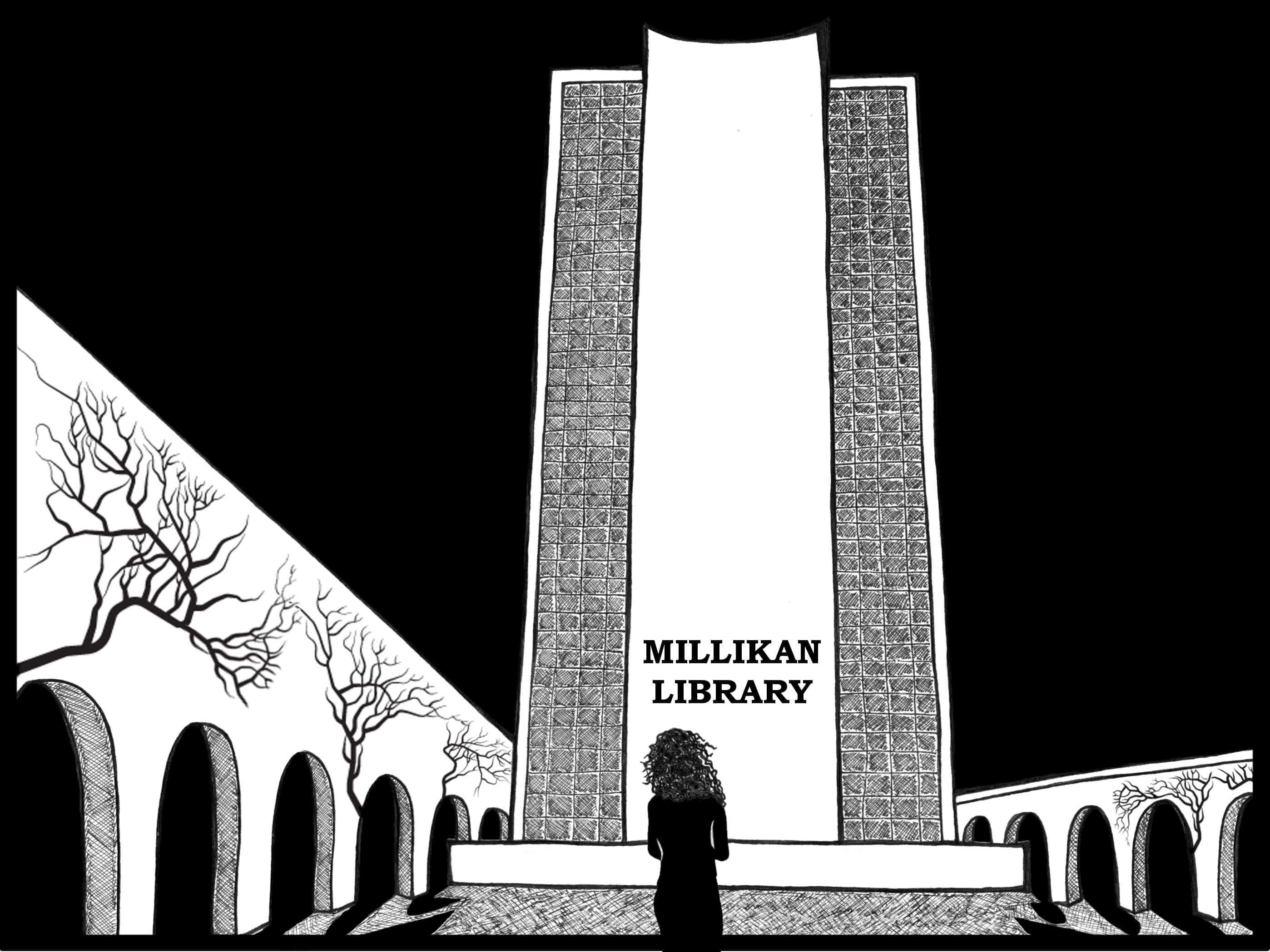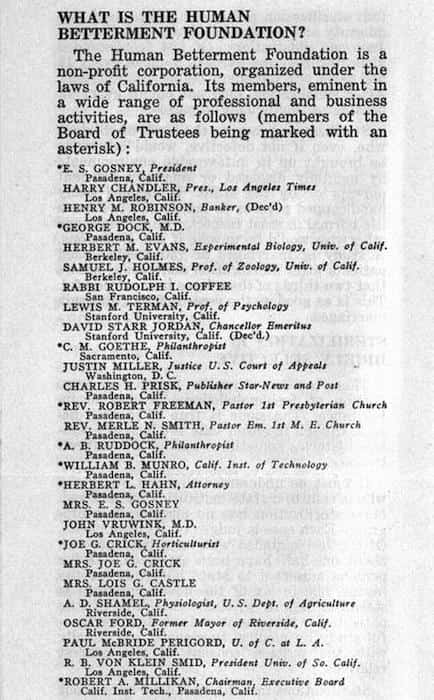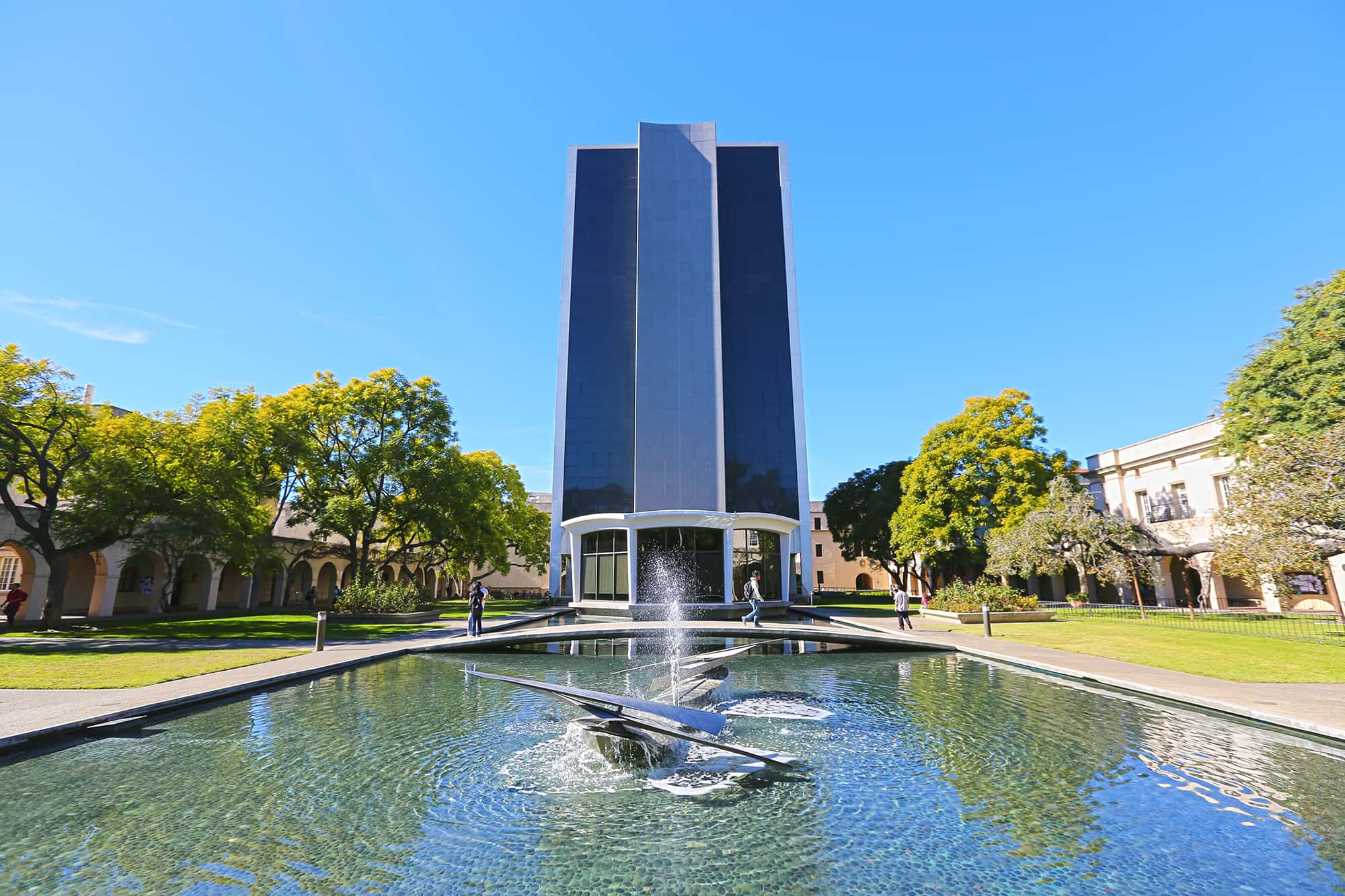
Illustration by Usha Lingappa for Caltech Letters
Viewpoint articles are a vehicle for members of the Caltech community to express their opinions on issues surrounding the interface of science and society. The views expressed here do not necessarily reflect the views of Caltech or the editorial board of Caltech Letters. Please see our disclaimer.
As protests for racial justice have forced a national reckoning, the Caltech community must confront its own legacy of exclusion, eugenics, and systemic racism. Adorning the walls of our institution are the leaders of the Human Betterment Foundation, a nationally prominent eugenicist organization that advocated for the forced sterilization of people based on race and disability. It is time to remove these names and replace them with ones we can be proud to celebrate.
Early Caltech luminaries Robert Millikan, A.B. Ruddock, Harry Chandler, Henry Robinson, William Munro, and E.S. Gosney promoted the field of eugenics as a scientific one, using their intellectual stature to claim that sterilizations were merely the “application of the discoveries made by science.” Their pamphlets emboldened California to carry out around 20,000 involuntary sterilizations, which were disproportionately performed on people of color.

The membership of the Human Betterment foundation in 1938, from their publication "Human Sterilization Today".
Library of Congress
The ideas of the men whose names are plastered around campus reached outside the U.S. as well, inspiring Nazi Germany’s use of sterilization. This was not an accident; the Foundation sent writings on California’s approach to Nazi administrators. Even after World War II, when the scope of the atrocities became clear, none of these men ever publicly renounced Nazi eugenics. It is clear that they were no mere products of their time but used their prestige to actively shape world events.
And yet, Caltech honors these eugenicists by naming buildings1, seminars, and fellowships for them: the Millikan Memorial Building, with its Millikan Library and Millikan Pond; the bust of Millikan; the Athenaeum’s Millikan Suite; the Robert A. Millikan Medal; the Robert A. Millikan Professorship; Ruddock House; Chandler Dining Hall; Linde+Robinson Laboratory; the William Bennett Munro History Seminar; and the Gosney Postdoctoral Fellowship.
Robert Millikan’s building looms as large over campus as his legacy does. Credited2 with transforming Caltech into the cutting-edge research institution it is today, Millikan is the university’s first Nobel laureate and is certainly the most celebrated person on campus. When I first saw his portrait on campus, I thought of Millikan’s Oil Drop Experiment, a beautiful measurement of an electron’s charge. There’s a certain thrill in realizing that such an important experiment was conducted by someone so entwined with Caltech (though even this accomplishment is disputed3).

The Millikan Memorial Building and Millikan Pond on Caltech's campus.
It was Millikan’s scientific stature as a “great” scientist that made his involvement in the Human Betterment Foundation so insidious: though many contemporary academics admonished Millikan and his colleagues for espousing pseudoscience, the Foundation promoted sterilization as scientific. In 1943, under the leadership of Millikan4, Caltech subsumed the Human Betterment Foundation, receiving its assets and documents under the condition that the university continue research “into the biological bases of human qualities.” These funds, as of 2019, are still used by the Division of Biology and Biological Engineering, effectively preserving the Human Betterment Foundation under the name of the Gosney Postdoctoral Fellowship.
And what of the rest of Millikan’s legacy? Along with his support of eugenics through the Human Betterment Foundation, he worked to ensure that San Marino property could not be owned by “any person whose blood is not entirely of the White… race.” In his administrative role, he first appealed to others before allowing Caltech’s first Black undergraduate to live in the student residences. In 1951, eighty-one years after the ratification of the 15th Amendment5 to the U.S. Constitution, he described the universal enfranchisement of African Americans as “an unthinkable disaster in view of the sort of people they are now.” These irrefutably racist actions and statements supported the kind of discrimination that we still live with today.
If Caltech were to erect a monument today, would anyone want it to celebrate Millikan? Does he match our current mission? Some may remember the Oil Drop Experiment, but many—particularly those that Caltech should be trying hardest to recruit—think of his eugenicist legacy. By honoring Millikan and his Human Betterment Foundation colleagues, we cannot help but honor their eugenicist contributions as well.
A building’s name symbolizes a university’s aspirations; it is not a historical marker. Renaming does not change the value of the eponym’s accomplishments. It is instead a recognition that the university’s values have changed. In its early days, Caltech did not shy away from renaming itself when it changed its mission: originally, we were founded as Throop6 University and, only after a series of renamings and other changes (which included the addition and removal of an elementary school), did we end up with the California Institute of Technology. The name changes were not erasures of history but symbolized changes in ambition. Today, Caltech’s purported mission is to “benefit society” and to create a “collegial” atmosphere. Yet, we hesitate to rename buildings that contradict this mission.
Perhaps the fear of renaming stems from the sense that to rename a building would be somehow disrespectful to the memory of Millikan. Disrespectful to our metaphoric elders. Of course, Millikan himself cannot benefit from these honors; the building in question was named only after his death (read: Millikan Memorial Building). There is also no fear that Robert Millikan will be forgotten: he has his Oil Drop Experiment and, if Caltech continues to be a world-renowned research institution, he has his name (for better or for worse) baked into its very creation. There’s no reason to keep it displayed on the most imposing building on campus.
Some suggest that renaming buildings will discourage our benefactors. Perhaps they will not want to donate to new buildings if there’s a chance we’ll remove their names from them in fifty years. But donating money, even if that money is needed, does not mean you control the aspirations and moral compass of a university. There is certainly precedent for refusing money that comes from problematic figures, and renaming should be no different. No new building is worth the loss of the university’s moral leadership.
What of the emotional resonance of a name? Ruddock House is an undergraduate residence that, unlike a regular building, represents both a strong community and a physical structure. Alumni may feel a loss, but they were united by the bonds they built there, not by the ideas of the eugenicist A. B. Ruddock himself. The name is only a stand-in, and it’s a poor one. Better to give alumni (and future alumni) a chance to rally around the name of a person that they would be proud to celebrate.
No person is perfectly moral in all aspects of their lives, and we should not expect them to be. But those who name buildings must judge individuals on their values and the implications of those values for today’s world. At a time when less than 1% of our graduate students are Black, the eugenicist legacy of Caltech’s forefathers is more salient than any arguably positive one. It should be no surprise that Black students at Caltech are advocating for removing these names and that they have tremendous support from the rest of our community. With such a poor track record of encouraging diversity—a result of choices made not just by Millikan, but by many after him—we bear the responsibility to repudiate that part of our past.
We chose to remember Millikan, Ruddock, Chandler, Robinson, Munro, and Gosney instead of remembering others. This was not a valueless choice. Caltech is not lacking in Nobel Laureates or other noted alumni whose statues and names could adorn campus. Just one of these people is James LuValle8, a photochemist and Olympic medalist who was also the first Black student to receive a Ph.D. from Caltech; to my knowledge, he is honored nowhere on our campus. By dismissing lesser-known honorees in favor of keeping the eugenicists, we create a self-fulfilling prophecy: the former are only unknown because we fail to make them known. Today, the decision to keep the current names is just as active a choice as changing them.

James LuValle (right), Caltech PhD and Olympic sprinter, crosses the 400 meter finish line at the 1936 Berlin Olympics.
IOC Olympic Museum, Switzerland
Two months ago, Caltech formed a committee to examine the names of campus buildings, promising an opportunity to reckon with our past. And yet, the only Black student on the task force publicly resigned from it, alleging that too much of the conversation centered on whether or not eugenics is bad and not nearly enough on how to address our university’s legacy.
The time to make excuses for our past is over; now we must chart a new path for our university9. Of course, Caltech must do much more to address the systemic racism, present from its foundation, than just renaming a few buildings. But renaming is an important step and something of a bare minimum.
We can no longer trust ineffective committees—we must demand that Caltech immediately change the names of our buildings, seminars, and fellowships that celebrate the Human Betterment Foundation.
Let us imagine ourselves better than our predecessors, and by imagining ourselves better perhaps we can become so. Let these aspirations be reflected on our walls.
Footnotes
1: Though not on this list, Watson Laboratory should also be renamed. Thomas Watson was not involved with the Human Betterment Fund, but Hitler gave him a medal “honoring foreign nationals who have made themselves deserving of the German Reich.” Though Watson later returned this medal, his involvement with Nazi Germany is reason enough to rename the building.
2: See page 13 of Millikan’s School: A History of the California Institute of Technology
3: It was probably Harvey Fletcher, Millikan’s graduate student, who first did the Oil Drop Experiment and was later coerced out of having his name on the Nobel-Prize-winning paper.
4: From 1921 to 1945, Millikan was the Chairman of the Executive Council of Caltech. This was, effectively, the role of President.
5: The 15th Amendment of the United States Constitution formally granted the right to vote to all citizens regardless of “race, color, or previous condition of servitude.”
6: Removing Throop’s name did not erase him from Caltech’s history, but there are no longer any buildings named for him: Throop Hall was damaged by an earthquake and replaced with a pond that technically bears Throop’s name but is often called the “Turtle Pond.” This is a shame, since Amos Throop was a fierce abolitionist: so much so that Abraham Lincoln refused7 to participate in a convention he chaired because its “abolitionist views” were “too strong for a man aspiring to public office.” Perhaps Throop’s name should replace Millikan’s on campus, as the site of Throop Hall was next to what became the Millikan Memorial Library.
7: See page 26 of Millikan’s School: A History of the California Institute of Technology
8: UCLA, where James LuValle got his undergraduate and master’s degrees, already has a prominent building named for him. We could follow their lead.
9: Caltech would not be the first to change the names of buildings honoring members of the Human Betterment Foundation: U.S.C and the city of Burbank have already done so.




